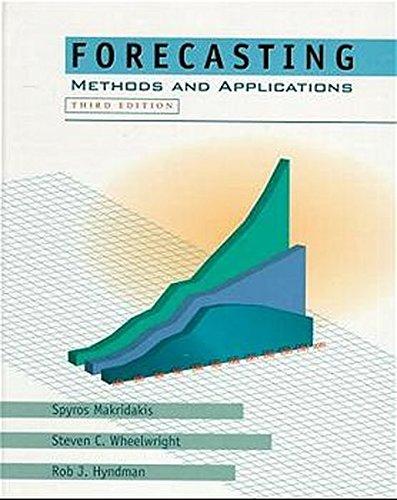Question
Let's suppose that your friend Marty has just inherited $1,000,000 in cash. He knows that you have completed a class in Portfolio Analysis and wants
Let's suppose that your friend Marty has just inherited $1,000,000 in cash. He knows that you have completed a class in Portfolio Analysis and wants you to help him invest the money. Marty is 30 years old, married, with two children ages 2 and 4. Marty is a computer engineer and is progressing in his career; his wife is a stay-at-home mom. Marty's employer provides group life, health, and disability insurance, but does not offer a 401K or other type of retirement plan. Apart from a $200,000 down payment on a house, Marty will use the remaining $800,000 of his recent windfall to fund both the educational expenses for his children and his retirement needs. He does not plan to withdraw any of the money until his older child starts college, 14 years from now, and he does not plan to retire until age 60. He says that he is willing to accept a moderate amount of risk. He is focused on capital appreciation, chieve portfolio stability as well as growt but he hopes that diversification will achieve portfolio stab 1. Go to the asset allocation wizard at https://smartasset.com/investing/asset-allocation- calculator. Examine the characteristics of each investment profile. Discuss Marty's risk tolerance, time horizon, liquidity needs, and other factors; and select an appropriate investment profile for him. The calculator will give an overview of the allocation to stocks - bonds - cash; as well as additional details within the stock category. Please fill in the proposed allocation to each asset class in the table below. (We will need this information, along with the projected annual total return and expected standard deviation for each asset class, in the next question.) Projected Return | Expected Standard Deviation Proposed Allocation Asset Class Stocks Large-cap Mid-cap Small-cap International Emerging markets Bonds Cash equivalents 9% 10% 12% 13% 18% 5% 2% 15% 17% 19% 21% 30% 9% 0%
2. Given the projected annual returns and proposed allocation, what is the expected annual return on the recommended portfolio? With the information given, is it possible to determine the expected standard deviation of the portfolio? Why or why not? Ignoring taxes and inflation, and assuming the expected annual return remains constant, what is the expected value of the portfolio in 14 years, when Marty's first child begins college?
4. Marty is very fond of cola beverages and wants to include either Coca-Cola (KO - NYSE) or Pepsi (PEP - NYSE) in the large-cap equity portion of the portfolio. Using the dividend discount model, which of the two stocks is more attractive? What are the assumptions we must make in order to use this model for valuation? (You should be able to develop the inputs for the DDM from Yahoo! Finance or other internet sources. Then compare the "intrinsic" DDM value of each company to its current market price.) Cite the sources of your data and show all work.
5. Rather than buy individual small-cap stocks, which tend to be risky, you decide to invest the small-cap portion of Marty's portfolio in a small-cap growth ETF with an enhanced strategy. You have identified three such funds and gathered the following information about their performance over the last year. Which of these three funds do you choose? Discuss at least three reasons for your choice. Alpha % R2 % Beta NAV Return % Benchmark Index* Return % Std dev % Sharpe Expense Ratio % Ratio % JKK +12.53 +16.09 20.01 0.54 0.30 JSML +14.01 +14.70 Shores Morningstar Small Cap Growth -5.05 8 1.22 1.21 Janus Henderson Small Cap Growth Alpha -2.10 66.20 1.12 Vanguard Small Cap Growth -1.23 86.66 1.15 S&P 500 Index 20.58 0.64 0.35 VBK +16.83 +16.84 18.38 0.79 0.07 Market Bench +16.11 mark *Benchmarks are Morningstar Small Growth Index (JKK), Janus Henderson Small Cap Growth Alpha Index (ISML), and CRSP U.S. Small Cap Growth Index (VBK) 6. You are thinking to buy some convertible notes or bonds for Marty's fixed income portfolio. You recall that we discussed Tesla's recent issue of 2% convertible notes due May 15, 2024. Each $1000 note is convertible into 3.2276 common shares, equal to an initial conversion price of $309.83 per share, and the notes are non-callable. For a while following the issue, Tesla shares were trading below $200 a share, but as of last Friday Dec 13 they were up to $358.39. Demand for the convertible notes has been brisk, and as of Friday, the notes traded at 134.605 % of par. a. At that price, what is the premium over conversion value for each note? b. Similar maturity non-convertible notes issued by Tesla are yielding 5.3%. At that yield, what is the straight investment value of the notes? What is the current premium over investment value for each note? C. Should we purchase the Tesla convertible notes for Marty's portfolio? Why or why not?
Step by Step Solution
There are 3 Steps involved in it
Step: 1

Get Instant Access to Expert-Tailored Solutions
See step-by-step solutions with expert insights and AI powered tools for academic success
Step: 2

Step: 3

Ace Your Homework with AI
Get the answers you need in no time with our AI-driven, step-by-step assistance
Get Started


